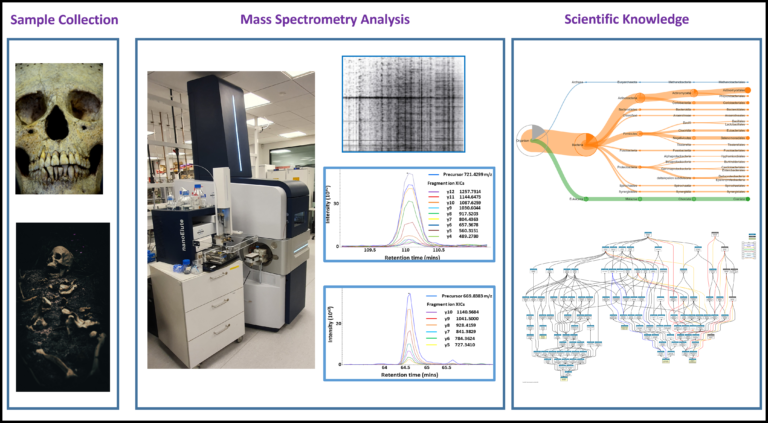Project Description
The environment in general, and climate in particular, are at times a catalyst for human resilience and adaptation. Notwithstanding, environmental and climatic variability can also have catastrophic effects on human health. In this project, we test the hypothesis that human diet and oral health tracks environmental and climatic variability. While supported by state-of-the-art archaeological method and theory, this project focuses on proteomics and osteological data analysis of human skeletal assemblages curated at the University of Aberdeen and Queen’s University Belfast. The project explores the role of the environment with respect to human health through consideration of how past societies responded to the impact of differential environmental conditions. Environmental (including climate) volatility is of major interest today and we will explore its influence on population health, disease loads and the diet of Medieval populations in Scotland and Ireland.
The environment clearly has a huge impact on human health both now and in the past. A knowledge of the effects of environmental conditions, and change, on the health of early historic communities in Scotland and Ireland has the potential to inform critical components of modern human health in the region, including oral health. The project will be the first to undertake a largescale proteomics analysis of samples of dental calculus from both Irish and Scottish Medieval skeletal populations. The process whereby dental plaque builds up on the surface of a tooth and becomes calcified (calculus) results in the entombment and preservation of biomolecules connected to both the oral microbiota and the individual. Additionally, inhaled and/or ingested microparticles may be related to the environment, human behaviour and foodstuffs. The presence of dietary particles on the teeth can provide direct evidence of the nature of foods consumed, which can complement more generalised measures of past diet, including dental palaeopathology, stable isotope analyses, zooarchaeology and analysis of plant remains. The preserved proteins are robust and highly diagnostic and different parts of plants (e.g. seeds versus leaves) and animals (e.g. muscle versus milk) can be identified (Tromp and Dudgeon 2015; Hendy et al. 2018; Velsko et al. 2022).
The integration of proteomic analysis of calculus with data derived from chronology, human osteoarchaeology and palaeopathology and other aspects of environmental archaeology, including plant microfossils and zooarchaeology, will enable an indepth exploration of the relationship between humans and their environment across the Medieval period of Ireland and Scotland.
Analysis of the calculus will provide:
1) A new dimension for the understanding of past diet at both individual and population level.
2) Insights into oral health and infectious disease through the integration of proteomic and osteological data.
3) Comparison of the oral biomes of children and adults.
The project will be supervised by biological scientists with expertise in proteomics and the oral microbiome in Queen’s University Belfast in collaboration with osteoarchaeologists based in the University of Aberdeen and Queen’s University Belfast. Training in proteomics analysis will be provided in Queen’s University, while training in Scottish and Irish Medieval archaeology and bioarchaeology will be provided in Aberdeen and Queen’s respectively.
CANDIDATE BACKGROUND
Experience with proteomics based extraction techniques. Experience of mass spectrometry based proteomics. Full training will be provided. Candidates must hold a UK 2.1 Bachelor’s degree or qualifications considered to be equivalent by the University in a Biosciences related degree and must have an interest in archaeology as they are going to have to engage with archaeological materials.
Image credits: Bobby Graham QUB, Michael Jerrard (Unsplash) and Jon Butterworth (Unsplash)
Supervisors
Bobby GrahamPrimary Supervisor: | Profile: Bobby Graham Email: r.graham@qub.ac.uk Institution: Queen's University, Belfast Department/School: School of Biological Sciences |
Rebecca CrozierSecondary Supervisor: | Profile: Rebecca Crozier Email: rebecca.crozier@abdn.ac.uk Institution: University of Aberdeen Department/School: School of Geosciences |
Eileen MurphyAdditional Supervisor: | Profile: Eileen Murphy Email: eileen.murphy@qub.ac.uk Institution: Queen's University, Belfast Department/School: School of Natural and Built Environment |
Additional Supervisor: | Dr Fionnuala Lundy, Queen’s University Belfast; School of Medicine, Dentistry and Biomedical Sciences Email: F.Lundy@qub.ac.uk |
References
Hendry, J. et al. 2018. Proteomic evidence of dietary sources in ancient dental calculus. Proceedings of the Royal Society B: Biological Sciences 285, https://doi.org/10.1098/rspb.2018.0977.
Tromp M. and Dudgeon J. V. 2015. Differentiating dietary and non-dietary microfossils extracted from human dental calculus: the importance of sweet potato to ancient diet on Rapa Nui. Journal of Archaeological Science 54, 54-63.
Velsko, I. M. et al. 2022. Ancient dental calculus preserves signatures of biofilm succession and interindividual variation independent of dental pathology. PNAS Nexus 1, 1-14.
QUADRAT Themes
- earth-systems






















































